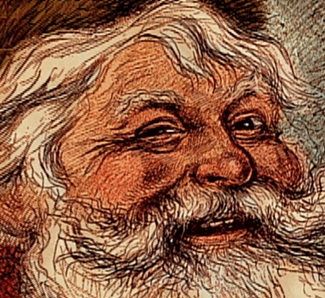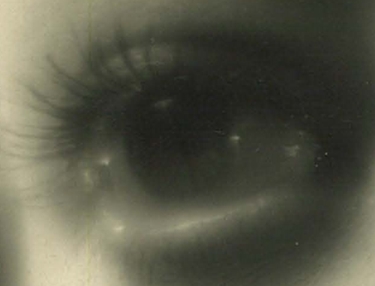 Do you recognize this eye on the left? “Should I?” I hear you ask. Well, no, of course not; I’m just having a little fun with you. I doubt if I myself could put a whole face to this fragment, the way they say a paleontologist can reconstruct an entire dinosaur from one or two bones. No, I don’t think I could do it — and I know who the eye belongs to.
Do you recognize this eye on the left? “Should I?” I hear you ask. Well, no, of course not; I’m just having a little fun with you. I doubt if I myself could put a whole face to this fragment, the way they say a paleontologist can reconstruct an entire dinosaur from one or two bones. No, I don’t think I could do it — and I know who the eye belongs to.
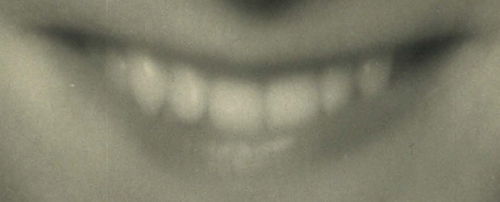 How about this smile on the right? Any guesses?
How about this smile on the right? Any guesses?
I won’t tease you much longer, I promise. This isn’t a mystery like that jigsaw puzzle of autographs I explored a few posts back. This time I know the whole back-story behind these fragments, and here it is.
When I was in college in the 1970s, my father had a friend, a drinking buddy, named Ted Sierka. When I knew him, Ted was…well, I guess you’d call him a barfly — a nice enough fellow, good-hearted, but a little sad and probably lonely. He lived in the back room of the Pocket Club, a rather ramshackle neighborhood bar located in the middle of what are now the southbound lanes of Interstate 5 through South Sacramento, Calif. Ted did a little bartending, a little janitoring, and a little night-watchman work in return for room and board and a few bucks a week for spending money. His only friend, besides the club’s owner (Don Somebody), my dad, and the other people he drank with, was a fat waddling beagle named Hey You.
Ted had a long résumé — or would have had, if he’d ever bothered to compile one — of jobs in what is now called the hospitality industry, mostly waiting tables in restaurants and bellhopping in hotels. (As a side note, there is one upscale eatery in Sacramento, quite famous locally for its plush ambiance and swanky menu, where Ted worked for a while; he said the place had the dirtiest kitchen he’d ever seen. Obviously I won’t name the establishment — besides, he may have merely been a disgruntled ex-employee.) Years earlier, as a fresh-faced lad of 23, Ted was a bellhop at the Sherry-Netherlands Hotel at 5th Avenue and Central Park South in New York City. One day in 1932, in the depths of the Great Depression, these two people came through town:
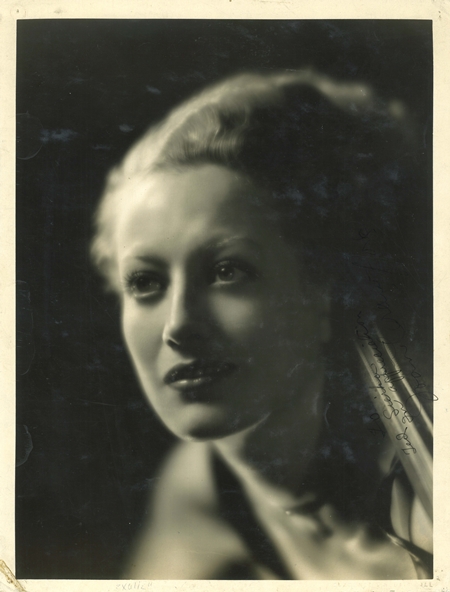
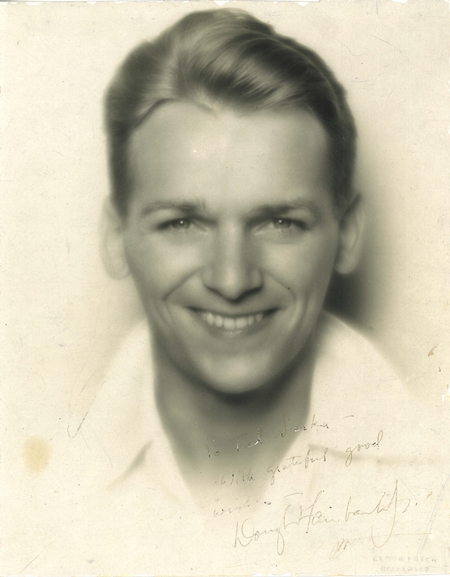 End of tease, all is revealed: The eye belongs to Joan Crawford, the smile to her then-husband Douglas Fairbanks Jr.
End of tease, all is revealed: The eye belongs to Joan Crawford, the smile to her then-husband Douglas Fairbanks Jr.
This was not only the Depression, it was also during the Noble Experiment of Prohibition — which only had a little over a year to run, although nobody knew that at the time. Ted was able to procure some liquor for the Sherry-Netherlands’ Hollywood guests, and his reward — part of it, anyhow — was these two photos. Autographed to him personally. They’re not too easy to read because first, Joan signed hers upside down in just about the only light spot on the photo (“To Ted Sierka, In appreciation. Joan Crawford”); and second, Doug (“To Ted Sierka — With grateful good wishes — Douglas Fairbanks Jr.”) signed with a sharp-nibbed fountain pen that dug some pretty serious divots into the surface of the picture. (The ball-point pen was the greatest boon to autograph seekers since the invention of ink.)
In reproducing these portraits here, I’ve resisted the temptation to retouch or digitally enhance them. They’re in extraordinarily good shape for a couple of 90-year-old photographs, but inevitably they’ve picked up a few marks and smudges over the decades. Still, I decided that at present it was best to scan and publish them exactly as they stood. The time may come, though, when I decide to have the scans spruced up and restored, either by myself or by someone expert and experienced at it. Fact is, they’re worth the effort, because they happen to be by two of the best and most esteemed photographers of the entire Hollywood Studio Era. Each photo is emboss-stamped with the photographer’s name in the lower right corner (if your monitor is big enough you can just about make them out), and the back of each is ink-stamped with a request to “please” and “kindly” give credit where it’s due. We’ll take them one at a time.
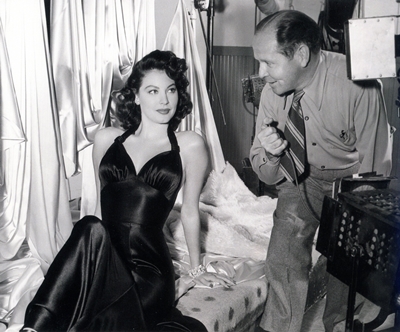 JOAN CRAWFORD The photo measures 13¼ x 10 in. The photographer was Clarence Sinclair Bull, shown here in a 1945 session with Ava Gardner. Born in Montana in 1896, he studied art under the western painter Charles M. Russell (according to Wikipedia, if we can believe them), but he segued at an early age into photography. At the time he took Ted Sierka’s photo of Joan Crawford, he was the head of MGM’s Still Photography Dept., and had been since before the studio even existed. In 1919 Sam Goldwyn hired Bull for his own production company. Goldwyn soon departed the company that bore his name (though strictly speaking, it was the other way around; the former Samuel Goldfish had changed his name to match the company’s), but Bull stayed on, and he was there in 1924 when the Goldwyn Co. merged with Metro and Louis B. Mayer to form MGM. Bull remained at the studio, riding herd on a sizable staff of talented photographers, until his retirement in 1961 — thus his time with the studio was longer than both Goldwyn’s and Mayer’s put together. In his retirement years he befriended the historian and collector John Kobal (founder of the vast Kobal Collection archive of movie-related images). Kobal inherited Bull’s scrapbooks and albums when he died in 1979, with the result that we know more about Bull’s career, and have more specimens of his work, than almost any of his colleagues from the studio era. An original silver-gelatin print of Joan Crawford, autographed on the front by her and on the back, stamped and numbered (B1901) by Clarence Sinclair Bull — this may be something not even Kobal ever knew existed.
JOAN CRAWFORD The photo measures 13¼ x 10 in. The photographer was Clarence Sinclair Bull, shown here in a 1945 session with Ava Gardner. Born in Montana in 1896, he studied art under the western painter Charles M. Russell (according to Wikipedia, if we can believe them), but he segued at an early age into photography. At the time he took Ted Sierka’s photo of Joan Crawford, he was the head of MGM’s Still Photography Dept., and had been since before the studio even existed. In 1919 Sam Goldwyn hired Bull for his own production company. Goldwyn soon departed the company that bore his name (though strictly speaking, it was the other way around; the former Samuel Goldfish had changed his name to match the company’s), but Bull stayed on, and he was there in 1924 when the Goldwyn Co. merged with Metro and Louis B. Mayer to form MGM. Bull remained at the studio, riding herd on a sizable staff of talented photographers, until his retirement in 1961 — thus his time with the studio was longer than both Goldwyn’s and Mayer’s put together. In his retirement years he befriended the historian and collector John Kobal (founder of the vast Kobal Collection archive of movie-related images). Kobal inherited Bull’s scrapbooks and albums when he died in 1979, with the result that we know more about Bull’s career, and have more specimens of his work, than almost any of his colleagues from the studio era. An original silver-gelatin print of Joan Crawford, autographed on the front by her and on the back, stamped and numbered (B1901) by Clarence Sinclair Bull — this may be something not even Kobal ever knew existed.
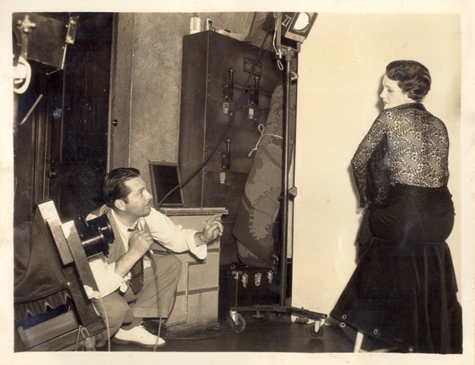 DOUGLAS FAIRBANKS JR. Measures 12 x 9½ inches, taken by Elmer Fryer, shown at right in an undated session with Mary Astor. Fryer was born in Missouri in 1898, and by 1929 he was head of the Stills Dept. at First National Pictures, staying on after First National was absorbed by Warner Bros. and remaining on the job until 1940. He died too early and too young (on March 3, 1944, age 46) to be discovered by the likes of John Kobal, so his name is less familiar than Clarence Bull, George Hurrell, and other Hollywood glamour photographers. Still, by 1934 he had taken some 16,000 pictures of Warners’ biggest stars; his portrait of Edward G. Robinson was even used as the model for a commemorative postage stamp in 2000. And, fortunately, Fryer still has his admirers today.
DOUGLAS FAIRBANKS JR. Measures 12 x 9½ inches, taken by Elmer Fryer, shown at right in an undated session with Mary Astor. Fryer was born in Missouri in 1898, and by 1929 he was head of the Stills Dept. at First National Pictures, staying on after First National was absorbed by Warner Bros. and remaining on the job until 1940. He died too early and too young (on March 3, 1944, age 46) to be discovered by the likes of John Kobal, so his name is less familiar than Clarence Bull, George Hurrell, and other Hollywood glamour photographers. Still, by 1934 he had taken some 16,000 pictures of Warners’ biggest stars; his portrait of Edward G. Robinson was even used as the model for a commemorative postage stamp in 2000. And, fortunately, Fryer still has his admirers today.
How that came about is a story in itself. Six months after he dropped dead at the corner of Hollywood and Vine in Los Angeles (reportedly of cirrhosis of the liver), up north in Oakland was born a son to Fryer’s daughter and her husband, a pilot in the U.S. Army Air Corps. That grandson grew up to be the Grammy-winning record producer and engineer Roger Nichols (best known for his early work with Donald Fagen and Walter Becker in the creation of Steely Dan). Nichols (who died in 2011) and other family members made it a matter of pride to keep the name of Elmer Fryer alive, and their dedication communicated itself to Nichols’s widow Conrad “Connie” Reeder, a singer/songwriter who (among other accomplishments) toured for 15 years with John Denver. Ms. Reeder has her own Web site, which includes a very informative page devoted to Grandpa Elmer. (NOTE: The picture here of Elmer Fryer at work is taken from that Web page. I reproduce it here under the Fair Use Doctrine, but it and other images on Ms. Reeder’s site are copyrighted by The Elmer Fryer Family Archive and all rights are reserved.) In addition to his work as a studio photographer, Elmer Fryer was a charter member of the American Society of Cinematographers in 1919. He was serving in the Army Air Corps during World War II, producing military documentaries and training films, at the time of his untimely death.
Theodore Robert Sierka died in Sacramento on May 17, 1978, four months shy of his 70th birthday. (This was a surprise to me; I would have guessed he was considerably older. Well, as the song says, “that’s what comes of too much pills and liquor.”) Some years before, Ted had given these pictures to my dad as keepsakes, and my dad in turn passed them on to me and my film-buff uncle — Doug for me, Joan for my uncle in Muncie, Ind.
Somewhere around 2005 or so, after my father himself had passed away, my uncle offered the photo of Joan for auction on eBay. He was in the process of divesting himself of his 16mm film collection and much of his memorabilia, and I think he had simply forgotten how he acquired the photo of Joan; in any case, he never mentioned the pending sale to me. Fortunately, I spotted the auction in my eBay browsing and was able to place the high bid, thereby keeping Joan in the family. These portraits have now been in my possession (and, for a while, my uncle’s) longer than they were in Ted’s.
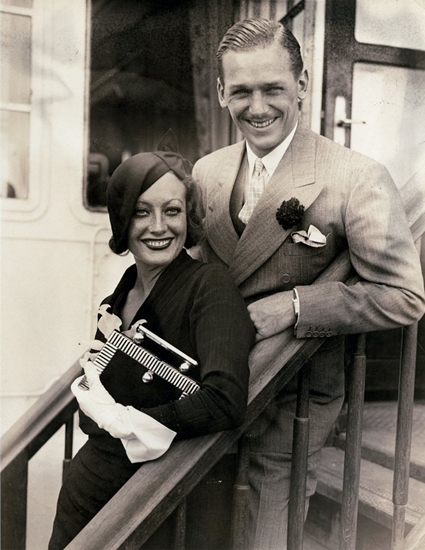 So the question is now: Exactly when did Ted Sierka supply Mr. and Mrs. Fairbanks Jr. with that liquor and get these photos in grateful appreciation? Actually, that’s not too difficult to nail down. Joan and Doug were married June 3, 1929 and Prohibition ended on December 5, 1933. But Crawford had filed for divorce in April of that year; in fact, the marriage had been rocky from the beginning, due to a combination of Crawford’s career obsession and Fairbanks’s youthful insecurity (he was only 19 when they were married; she was nearly five years older). Besides, both their careers were going great guns during the switchover to talking pictures: Doug made twenty movies between 1929 and ’32; Joan made sixteen. They didn’t even have time for a honeymoon until they’d been married for three years.
So the question is now: Exactly when did Ted Sierka supply Mr. and Mrs. Fairbanks Jr. with that liquor and get these photos in grateful appreciation? Actually, that’s not too difficult to nail down. Joan and Doug were married June 3, 1929 and Prohibition ended on December 5, 1933. But Crawford had filed for divorce in April of that year; in fact, the marriage had been rocky from the beginning, due to a combination of Crawford’s career obsession and Fairbanks’s youthful insecurity (he was only 19 when they were married; she was nearly five years older). Besides, both their careers were going great guns during the switchover to talking pictures: Doug made twenty movies between 1929 and ’32; Joan made sixteen. They didn’t even have time for a honeymoon until they’d been married for three years.
That came, according to Doug’s autobiography The Salad Days, in June 1932. Taking a long-deferred break from moviemaking, they planned to sail from New York for a European honeymoon. Salad Days suggests that Doug hoped the vacation might save their marriage, but that may have been hindsight from 1988, when he was writing. In any case, Doug assures us that Joan had a lousy time once they sailed. She put on a brave face and played the good sport, but all the time they were gone she couldn’t wait to get back into harness at MGM; she didn’t return to Europe for years, long after their marriage was over. So those few days’ sojourn in New York, before they sailed for Europe on the German liner S.S. Bremen, offers the most likely time for their paths to cross Ted Sierka’s.
Evidently, however, it wasn’t at the Sherry-Netherlands. In The Salad Days Doug clearly recalls that they stayed at the Hotel St. Moritz — their studios, MGM (Joan’s) and Warner Bros. (Doug’s), were footing the bill for their honeymoon, and that’s where they booked them. Personally, I trust Doug’s memory here more than Ted’s. Maybe Ted worked both hotels at different times and simply misremembered where he met the couple. On the other hand, it’s only a four-minute walk from the Sherry-Netherlands to the St. Moritz; maybe Doug and Joan’s bellhop said, “Let me call a friend over at the Sherry; maybe he can find something…” (if so, I wonder what that bellhop got out of the deal). Both Doug’s and Ted’s memories may have been correct.
There are questions I wish I could go back and ask Ted now. What did he supply to Doug and Joan, bathtub gin or the real stuff? The real stuff, probably scotch, I’d guess, but I don’t know. How much? One bottle? Two? A case? Not a case, I’d guess, probably just enough to tide them over till they sailed; after that, they could buy all they wanted, as long as they didn’t try to bring it back into the country. But I don’t know. When did Doug and Joan sign these photos? On the spot? Next day? I tend to doubt that they carried these oversize photos around ready to sign and hand out; my guess is they called MGM and Warners’ New York offices and had them sent over to the hotel. But I don’t know. And everybody’s beyond asking about it now.
I may have blown a chance to get some of these questions answered. Late in his life, around 1996 or so, Doug came to Sacramento for one of his An Evening with Douglas Fairbanks Jr. personal appearances. I toyed with the idea of sending Elmer Fryer’s portrait of him backstage with a note: “In 1932 you signed this picture for my friend Ted Sierka. Will you sign it again for me now?” But I didn’t; I didn’t even go. My reasons seemed to me good and sufficient at the time — but now, I can’t for the life of me imagine what they were.
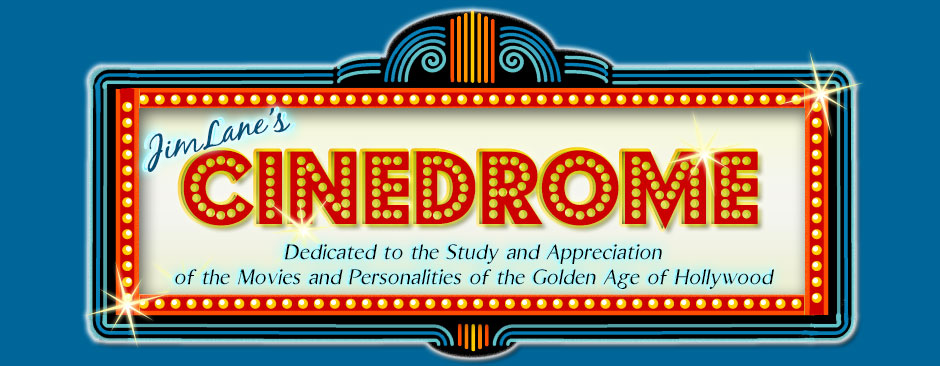
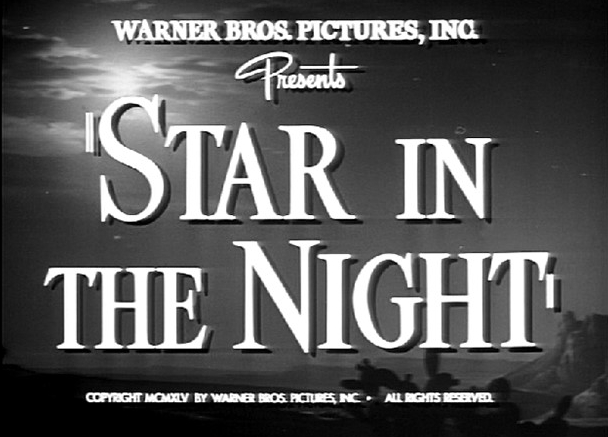 As we all decompress from the Holiday Season, I want to pause and pay tribute to a particular Christmas movie, one of the least known and one of the best. It distills the spirit of Christmas as well as — sometimes better than — more familiar titles, worthy as they are. Without being preachy or even overtly religious, it presents that spirit in the form of a parable — the form, in fact, favored by Jesus himself in the Gospels. And it’s only 22 minutes long.
As we all decompress from the Holiday Season, I want to pause and pay tribute to a particular Christmas movie, one of the least known and one of the best. It distills the spirit of Christmas as well as — sometimes better than — more familiar titles, worthy as they are. Without being preachy or even overtly religious, it presents that spirit in the form of a parable — the form, in fact, favored by Jesus himself in the Gospels. And it’s only 22 minutes long.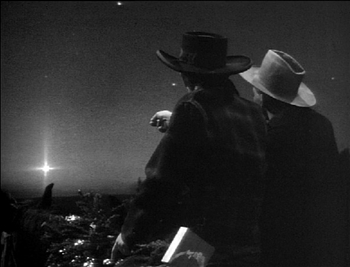 It’s called Star in the Night, released by Warner Bros. on October 13, 1945. It opens on a cold night (Christmas Eve, as we later learn) somewhere in the desert of the American Southwest — Arizona, perhaps, or Nevada or New Mexico. Three cowboys are ambling along on horseback. Their arms and saddles are laden with toys, Yuletide decorations and other “doodads” which, in a spasm of holiday cheer, they have bought from a general store in the town they left back a ways, though they haven’t the slightest idea what to do with them or whom they might give them to.
It’s called Star in the Night, released by Warner Bros. on October 13, 1945. It opens on a cold night (Christmas Eve, as we later learn) somewhere in the desert of the American Southwest — Arizona, perhaps, or Nevada or New Mexico. Three cowboys are ambling along on horseback. Their arms and saddles are laden with toys, Yuletide decorations and other “doodads” which, in a spasm of holiday cheer, they have bought from a general store in the town they left back a ways, though they haven’t the slightest idea what to do with them or whom they might give them to. 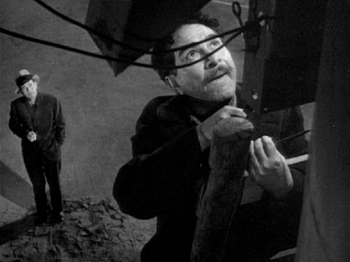
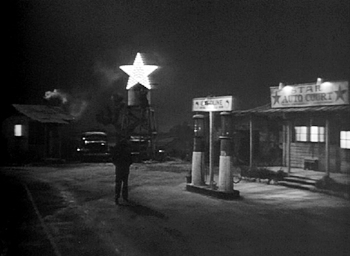 The camera takes us there long before the cowboys have time to arrive. It turns out the star the cowboys see is no astronomical phenomenon; it’s an advertising sign, illuminated by 102 light bulbs. Recently purchased from a defunct movie theater (“Star Picture Palace”), it’s been newly installed over a roadside inn, the Star Auto Court. As a lone vagabond approaches from the road, the Star’s proprietor, Nick Catapoli (J. Carroll Naish) struggles to keep the star lit, hoping its brilliant light will catch the eye of highway travelers for miles around.
The camera takes us there long before the cowboys have time to arrive. It turns out the star the cowboys see is no astronomical phenomenon; it’s an advertising sign, illuminated by 102 light bulbs. Recently purchased from a defunct movie theater (“Star Picture Palace”), it’s been newly installed over a roadside inn, the Star Auto Court. As a lone vagabond approaches from the road, the Star’s proprietor, Nick Catapoli (J. Carroll Naish) struggles to keep the star lit, hoping its brilliant light will catch the eye of highway travelers for miles around.
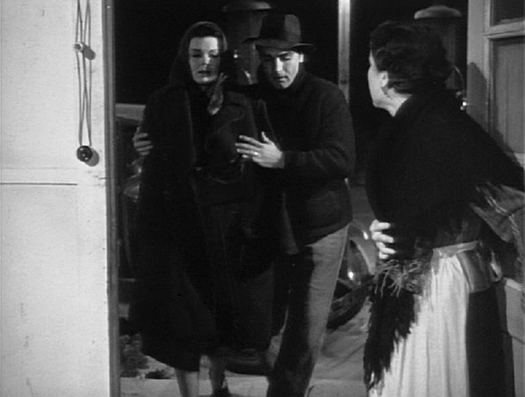
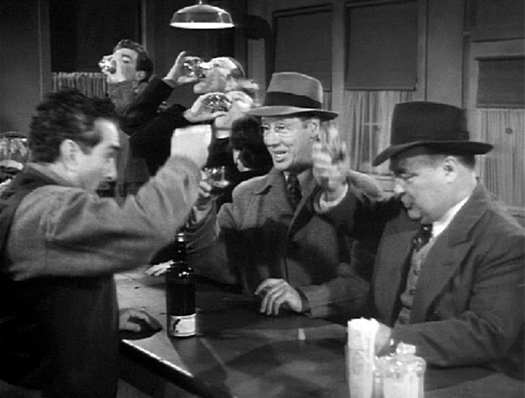 My late uncle remembered seeing Star in the Night as a 15-year-old and being deeply impressed. He wasn’t alone; at the Academy Awards Ceremony in Grauman’s Chinese Theatre on March 7, 1946, Star‘s producer Gordon Hollingshead took home the Oscar for the best two-reel short subject of 1945. After that, Star in the Night simply dropped off the face of the earth and was as utterly forgotten as any film of the sound era has ever been. Myself, I had never heard of it before I stumbled across a 16mm print up for auction on eBay in 2008. The listing piqued my interest, and a follow-up check of the IMDb was an eye-opener: J. Carroll Naish?? Irving Bacon?? Dick Elliott?? Richard Erdman?? Don Siegel??? Academy Award?!?
My late uncle remembered seeing Star in the Night as a 15-year-old and being deeply impressed. He wasn’t alone; at the Academy Awards Ceremony in Grauman’s Chinese Theatre on March 7, 1946, Star‘s producer Gordon Hollingshead took home the Oscar for the best two-reel short subject of 1945. After that, Star in the Night simply dropped off the face of the earth and was as utterly forgotten as any film of the sound era has ever been. Myself, I had never heard of it before I stumbled across a 16mm print up for auction on eBay in 2008. The listing piqued my interest, and a follow-up check of the IMDb was an eye-opener: J. Carroll Naish?? Irving Bacon?? Dick Elliott?? Richard Erdman?? Don Siegel??? Academy Award?!? 